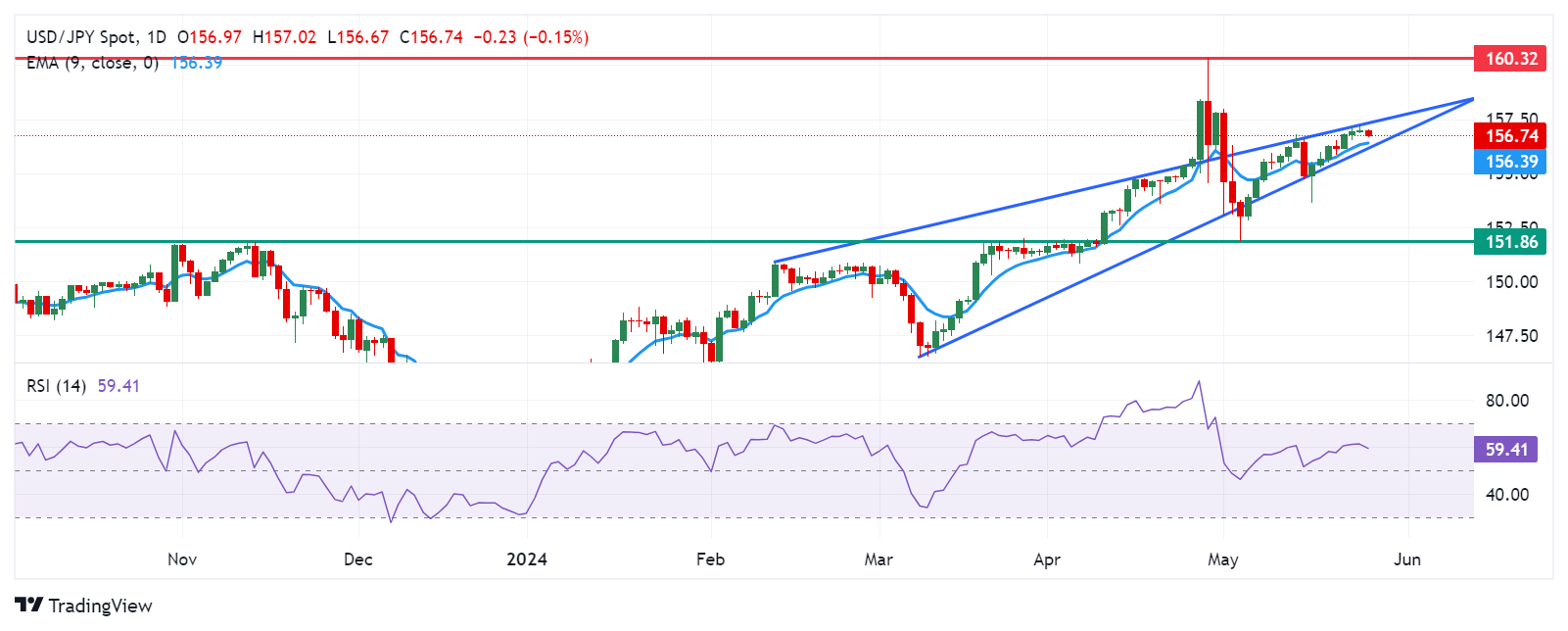- The Japanese Yen gained ground amid improved risk appetite on Monday.
- BoJ Governor Kazuo Ueda said there is a need to re-anchor inflation expectations at the 2% target.
- The US Dollar lost ground due to the lower 10-year US Treasury yield after softer UoM 5-year Inflation Expectation.
The Japanese Yen (JPY) halted its three-day losing streak, possibly influenced by comments from Bank of Japan (BoJ) Governor Kazuo Ueda on Monday. Ueda remarked that progress has been made in moving away from zero and raising inflation expectations, but there is a need to re-anchor them, this time at the 2% target. He also said that the BoJ will proceed cautiously, aligning with other central banks that have inflation-targeting frameworks.
Japan's annual inflation rate remained above the Bank of Japan’s 2% target. This sustained inflationary trend exerts pressure on the central bank to contemplate policy tightening. The BoJ has underscored the importance of a virtuous cycle characterized by sustained and stable attainment of its 2% price target, coupled with robust wage growth, as essential for policy normalization.
The US Dollar Index (DXY), which measures the value of the US Dollar (USD) against the six other major currencies, trades near 104.70 by the press time. On Friday, the Greenback lost ground due to the lower 10-year US Treasury yield, which stood at 4.46%. This could be attributed to the improved risk sentiment after the softer University of Michigan's 5-year Consumer Inflation Expectations for May on Friday.
Daily Digest Market Movers: Japanese Yen advances after remarks from BoJ officials
- BoJ Deputy Governor Shinichi Uchida stated on Monday that they have reverted to a conventional monetary policy framework, with the objective of achieving a 2% price stability target through adjustments of the short-term policy rate. Uchida also said that they have successfully navigated past the zero-lower bound.
- UoM 5-year Consumer Inflation Expectations eased slightly to 3.0%, falling below the forecasted 3.1%. Despite the upward revision of the Consumer Sentiment Index to 69.1 from a preliminary reading of 67.4, it still indicated the lowest level in six months. These figures likely bolstered investors’ sentiment regarding potential rate cuts by the Federal Reserve.
- According to the CME FedWatch Tool, the probability of the Federal Reserve implementing a 25 basis-point rate cut in September has decreased to 44.9% from 49.0% a week earlier.
- On Friday, the US Census Bureau released Durable Goods Orders, indicating a strong rebound in April with a 0.7% MoM increase, contrasting the forecasted 0.8% decline. However, March’s figure was revised downward to 0.8% from the initial estimate of 2.6%.
- Japan’s National Consumer Price Index (CPI) dropped to 2.5% YoY in April from 2.7% in the previous month, marking the second consecutive month of moderation but still staying above the Bank of Japan’s (BoJ) 2% target. This sustained inflation keeps pressure on the central bank to consider further policy tightening.
- Japan’s 10-year government bond yield surpassed 1% last week for the first time since May 2013, fueled by traders' increasing bets that the Bank of Japan would tighten policy further in 2024.
Technical Analysis: USD/JPY drops toward 156.50
The USD/JPY pair trades close to 156.70 on Monday. A potential bearish reversal is indicated by the emerging rising wedge pattern on the daily chart, as the pair nears the wedge's apex. However, the 14-day Relative Strength Index (RSI) maintains a slightly bullish bias, staying above 50. A drop below this threshold would suggest a shift in momentum.
The USD/JPY pair might retest the upper boundary of the rising wedge around 157.30. Should it exceed this level, the pair could aim for 160.32, marking its highest point in more than thirty years.
In terms of support, the nine-day Exponential Moving Average (EMA) at 156.40 stands as immediate support, followed by the lower edge of the rising wedge and the psychological level of 156.00. If breached, these levels could exert downward pressure on the USD/JPY pair, potentially guiding it toward the throwback support at 151.86.
USD/JPY: Daily Chart
Japanese Yen price today
The table below shows the percentage change of the Japanese Yen (JPY) against listed major currencies today. Japanese Yen was the strongest against the Swiss Franc.
| USD | EUR | GBP | CAD | AUD | JPY | NZD | CHF | |
| USD | -0.02% | -0.06% | -0.04% | -0.24% | -0.01% | -0.18% | 0.08% | |
| EUR | 0.02% | -0.05% | -0.02% | -0.22% | 0.00% | -0.16% | 0.10% | |
| GBP | 0.06% | 0.04% | 0.02% | -0.18% | 0.06% | -0.12% | 0.12% | |
| CAD | 0.04% | 0.02% | -0.04% | -0.25% | 0.04% | -0.14% | 0.11% | |
| AUD | 0.23% | 0.22% | 0.17% | 0.20% | 0.24% | 0.06% | 0.31% | |
| JPY | 0.01% | -0.02% | -0.06% | -0.03% | -0.28% | -0.18% | 0.06% | |
| NZD | 0.20% | 0.17% | 0.12% | 0.14% | -0.06% | 0.18% | 0.26% | |
| CHF | -0.07% | -0.11% | -0.12% | -0.11% | -0.31% | -0.07% | -0.25% |
The heat map shows percentage changes of major currencies against each other. The base currency is picked from the left column, while the quote currency is picked from the top row. For example, if you pick the Euro from the left column and move along the horizontal line to the Japanese Yen, the percentage change displayed in the box will represent EUR (base)/JPY (quote).
Japanese Yen FAQs
The Japanese Yen (JPY) is one of the world’s most traded currencies. Its value is broadly determined by the performance of the Japanese economy, but more specifically by the Bank of Japan’s policy, the differential between Japanese and US bond yields, or risk sentiment among traders, among other factors.
One of the Bank of Japan’s mandates is currency control, so its moves are key for the Yen. The BoJ has directly intervened in currency markets sometimes, generally to lower the value of the Yen, although it refrains from doing it often due to political concerns of its main trading partners. The current BoJ ultra-loose monetary policy, based on massive stimulus to the economy, has caused the Yen to depreciate against its main currency peers. This process has been exacerbated more recently due to an increasing policy divergence between the Bank of Japan and other main central banks, which have opted to increase interest rates sharply to fight decades-high levels of inflation.
The BoJ’s stance of sticking to ultra-loose monetary policy has led to a widening policy divergence with other central banks, particularly with the US Federal Reserve. This supports a widening of the differential between the 10-year US and Japanese bonds, which favors the US Dollar against the Japanese Yen.
The Japanese Yen is often seen as a safe-haven investment. This means that in times of market stress, investors are more likely to put their money in the Japanese currency due to its supposed reliability and stability. Turbulent times are likely to strengthen the Yen’s value against other currencies seen as more risky to invest in.
Information on these pages contains forward-looking statements that involve risks and uncertainties. Markets and instruments profiled on this page are for informational purposes only and should not in any way come across as a recommendation to buy or sell in these assets. You should do your own thorough research before making any investment decisions. FXStreet does not in any way guarantee that this information is free from mistakes, errors, or material misstatements. It also does not guarantee that this information is of a timely nature. Investing in Open Markets involves a great deal of risk, including the loss of all or a portion of your investment, as well as emotional distress. All risks, losses and costs associated with investing, including total loss of principal, are your responsibility. The views and opinions expressed in this article are those of the authors and do not necessarily reflect the official policy or position of FXStreet nor its advertisers. The author will not be held responsible for information that is found at the end of links posted on this page.
If not otherwise explicitly mentioned in the body of the article, at the time of writing, the author has no position in any stock mentioned in this article and no business relationship with any company mentioned. The author has not received compensation for writing this article, other than from FXStreet.
FXStreet and the author do not provide personalized recommendations. The author makes no representations as to the accuracy, completeness, or suitability of this information. FXStreet and the author will not be liable for any errors, omissions or any losses, injuries or damages arising from this information and its display or use. Errors and omissions excepted.
The author and FXStreet are not registered investment advisors and nothing in this article is intended to be investment advice.
Recommended content
Editors’ Picks

AUD/USD faces the next hurdle at 0.6400
AUD/USD rose markedly and approached the key 0.6400 hurdle at the beginning of the week, always in response to rising weakness in the US Dollar and hopes of fresh stimulus in China.

EUR/USD keeps the upside target at 1.1000
EUR/USD extended further Friday’s recovery and traded at shouting distance from the YTD peaks near 1.0950 in response to increased selling pressure in the Greenback and the improved political scenario in Germany.

Gold consolidates around $3,000 ahead of Fed
Gold prices has started the week on a positive tone and maintains their trade around the key $3,000 mark per troy ounce on the back of the modest pullback in the Greenback and mixed US yields across the curve,

Crypto markets could gain $1 trillion as Gold price reaches $3,000: Tokenized-Gold expert explains
Tokenized-Gold assets hit a $1.8 billion market cap on Monday after the Gold (XAU) price marked new all-time highs above $3,000 per troy ounce. In an exclusive interview with FXStreet, RAAC CEO Kevin Rusher explains how tokenized Gold assets could impact the next crypto market recovery phase.

Five Fundamentals for the week: Fed leads central bank parade as uncertainty remains extreme Premium
Central bank bonanza – perhaps its is not as exciting as comments from the White House, but central banks still have sway. They have a chance to share insights about the impact of tariffs, especially when they come from the world's most powerful central bank, the Fed.

The Best brokers to trade EUR/USD
SPONSORED Discover the top brokers for trading EUR/USD in 2025. Our list features brokers with competitive spreads, fast execution, and powerful platforms. Whether you're a beginner or an expert, find the right partner to navigate the dynamic Forex market.
